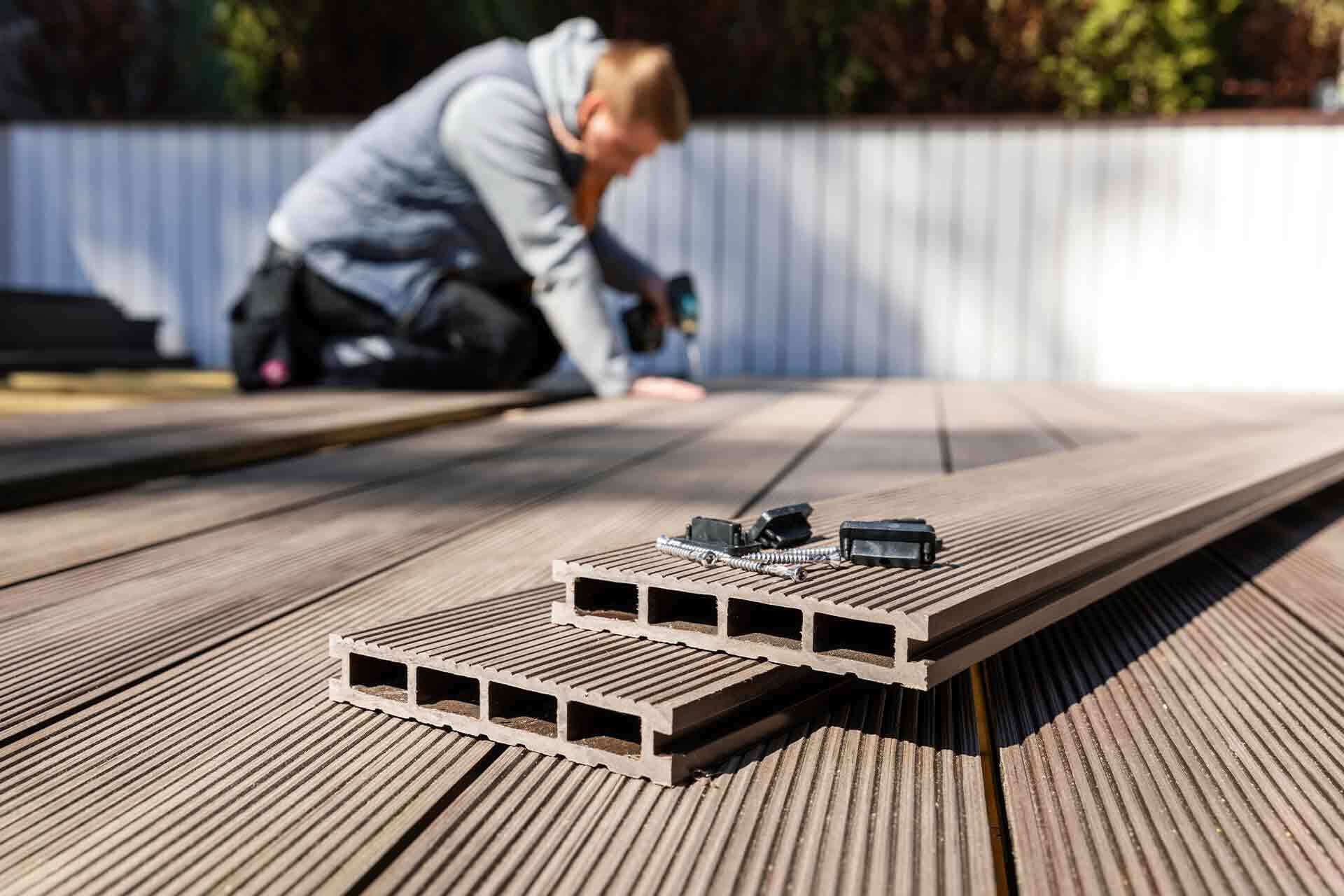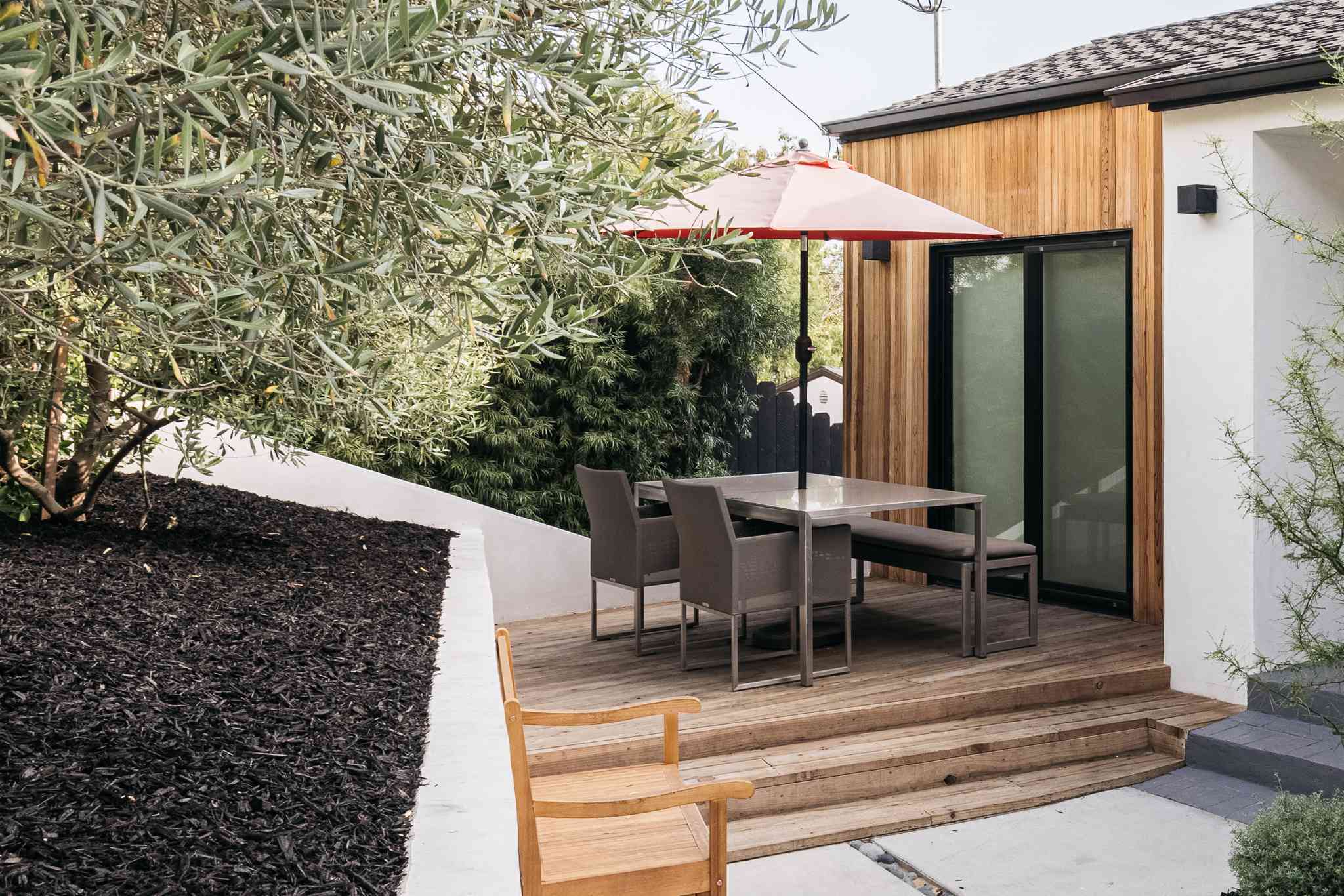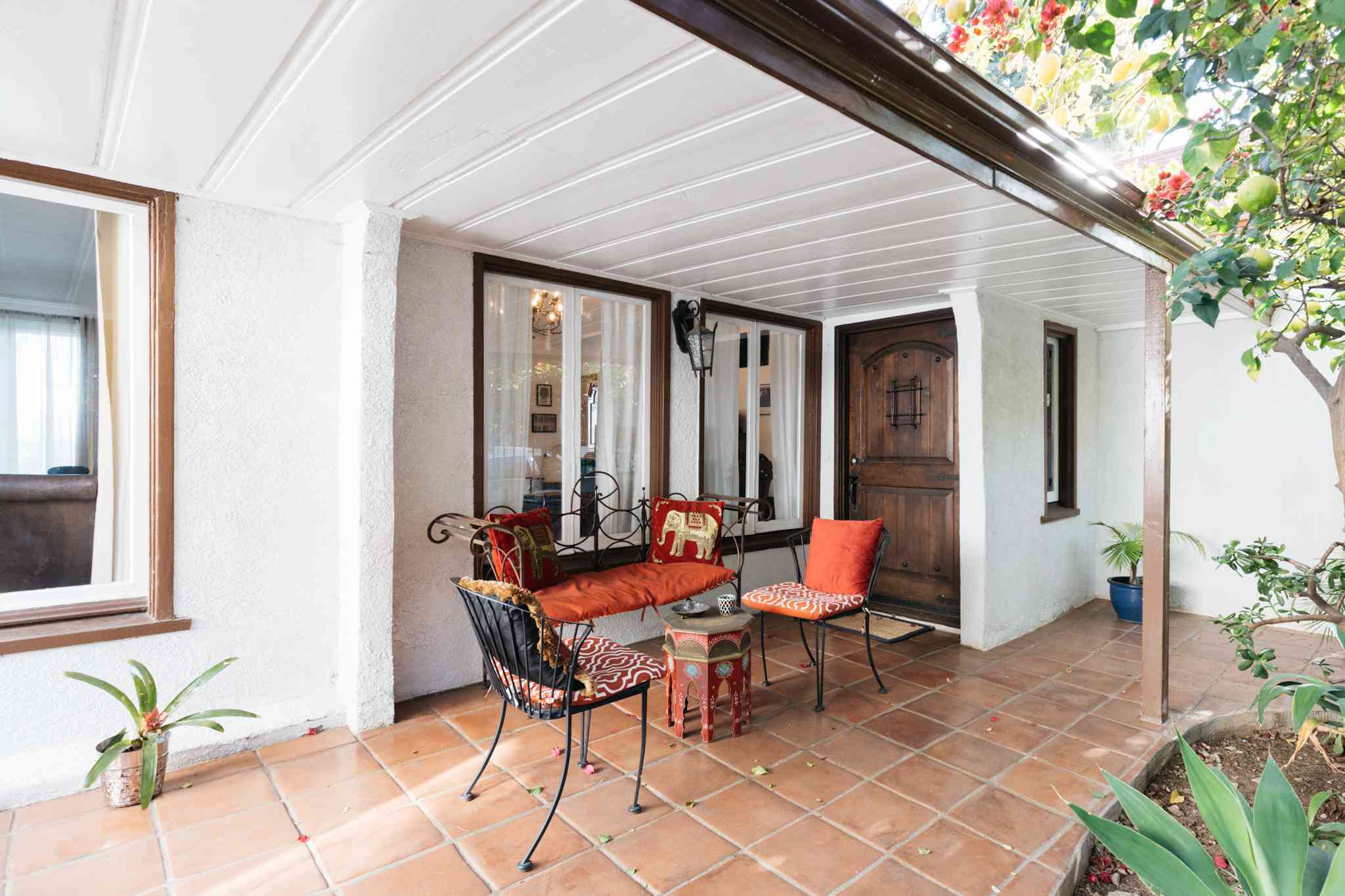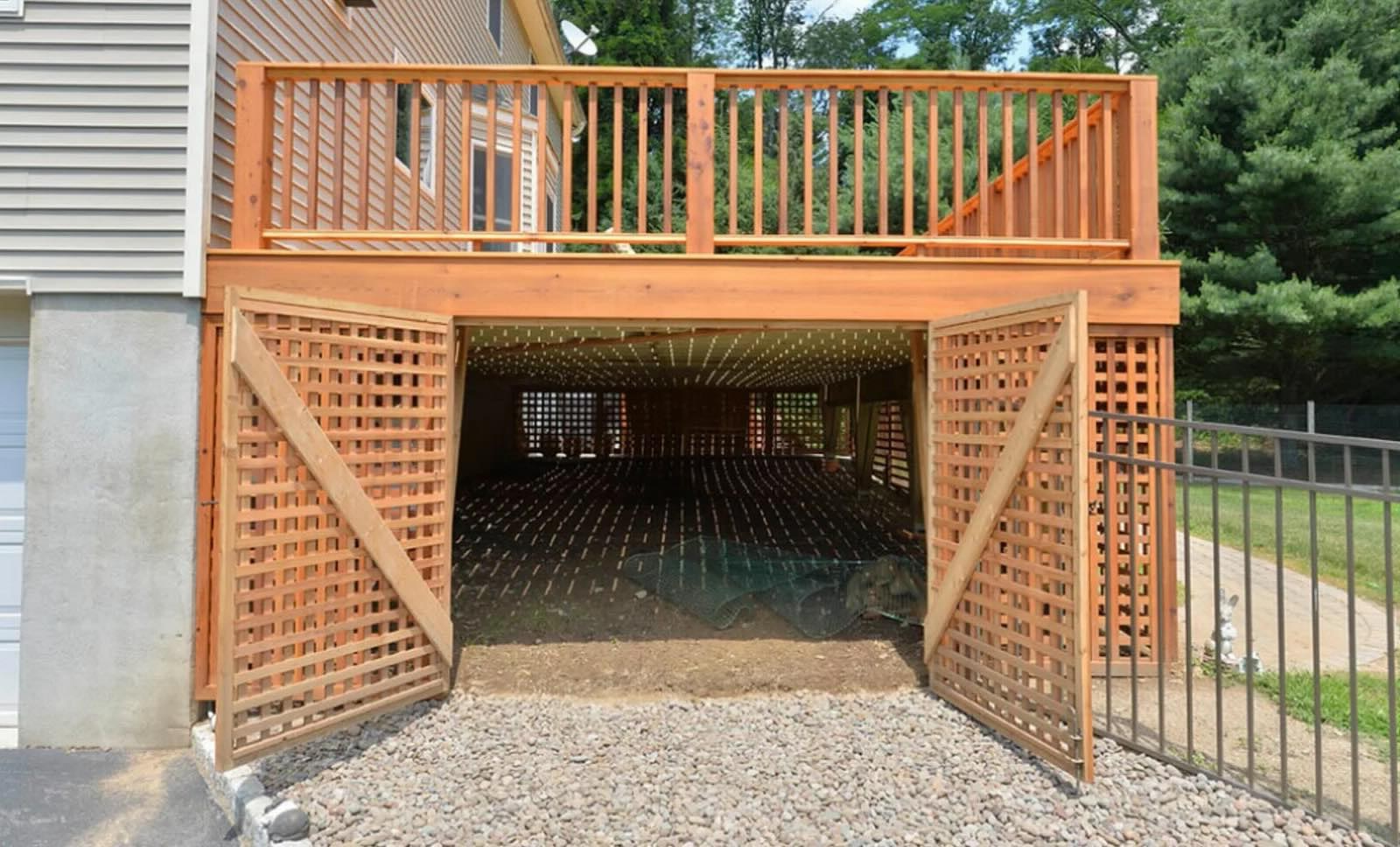Home>Create & Decorate>DIY & Crafts>DIY Composite Deck: Step-by-Step Guide To Building A Stunning Outdoor Space


DIY & Crafts
DIY Composite Deck: Step-by-Step Guide To Building A Stunning Outdoor Space
Published: February 23, 2024

Senior Editor in Create & Decorate, Kathryn combines traditional craftsmanship with contemporary trends. Her background in textile design and commitment to sustainable crafts inspire both content and community.
Learn how to build a beautiful outdoor space with our step-by-step guide to DIY composite deck construction. Perfect for DIY & Crafts enthusiasts.
(Many of the links in this article redirect to a specific reviewed product. Your purchase of these products through affiliate links helps to generate commission for Twigandthistle.com, at no extra cost. Learn more)
Introduction
Welcome to the ultimate guide for creating your very own stunning composite deck! Whether you're an experienced DIY enthusiast or a newcomer to the world of outdoor projects, this step-by-step guide will equip you with the knowledge and confidence to transform your outdoor space into a captivating oasis.
Building a composite deck is a rewarding endeavor that not only enhances the aesthetic appeal of your home but also provides a functional and versatile area for relaxation, entertainment, and family gatherings. With the right tools, materials, and a clear plan in place, you can bring your vision to life and create a space that seamlessly blends with the natural beauty of your surroundings.
In this comprehensive guide, we will walk you through each stage of the process, from initial planning and design to the final touches that add personality and charm to your deck. You'll learn how to select the perfect location, gather the necessary materials and tools, prepare the site, construct the frame, install the composite decking, and add those finishing details that make your deck uniquely yours.
Whether you envision a cozy retreat for morning coffee, a spacious area for outdoor dining and entertaining, or a multifunctional space that accommodates various activities, this guide will empower you to customize your deck to suit your lifestyle and preferences. Additionally, we'll provide valuable maintenance and care tips to ensure that your composite deck remains a stunning focal point for years to come.
So, roll up your sleeves, unleash your creativity, and get ready to embark on an exciting journey of craftsmanship and transformation. By the end of this guide, you'll be equipped with the knowledge and inspiration to build a composite deck that not only elevates the beauty of your outdoor space but also becomes a beloved extension of your home. Let's dive in and bring your dream deck to life!
Read more: How To Build Composite Deck
Planning and Designing Your Composite Deck
Planning and designing your composite deck is the crucial first step in creating a captivating outdoor space that seamlessly integrates with your lifestyle and the natural surroundings of your home. This phase sets the foundation for the entire project, allowing you to envision the layout, functionality, and aesthetic elements that will define your deck.
Assessing Your Needs and Vision
Before diving into the specifics of your deck design, take the time to assess your needs, preferences, and vision for the space. Consider how you intend to use the deck – whether it's for hosting gatherings, enjoying quiet moments of relaxation, or accommodating specific activities such as outdoor cooking or gardening. Understanding your primary objectives will guide the design process and ensure that the final result aligns with your lifestyle.
Choosing the Right Location
Selecting the optimal location for your composite deck is a pivotal decision that can significantly impact its usability and visual appeal. Take into account factors such as sunlight exposure, privacy, views, and proximity to indoor living spaces. Additionally, consider the natural features of your property, such as trees, landscaping, and terrain, as these elements can influence the overall ambiance of the deck.
Designing the Layout and Structure
Once you've identified the location, it's time to conceptualize the layout and structure of your deck. Determine the size, shape, and flow of the space, keeping in mind the potential for different zones, such as dining areas, lounging spaces, and built-in features like planters or benches. Pay attention to the architectural style of your home and aim for a design that harmonizes with its aesthetic while reflecting your personal taste.
Selecting Materials and Finishes
Choosing the right materials and finishes is essential for achieving a cohesive and visually appealing deck design. When it comes to composite decking, explore the various colors, textures, and profiles available to find the perfect match for your vision. Consider complementary elements such as railing systems, lighting, and decorative accents to enhance the overall look and functionality of the space.
Incorporating Personal Touches
Finally, don't overlook the opportunity to infuse your deck design with personal touches that reflect your individuality and style. Whether it's incorporating a specific color scheme, integrating unique features, or adding elements of greenery and natural decor, these personal touches will elevate the character of your deck and make it a true extension of your home.
By carefully planning and designing your composite deck, you'll lay the groundwork for a project that not only meets your practical needs but also fulfills your desire for a visually stunning and inviting outdoor retreat. This thoughtful approach ensures that every aspect of your deck aligns with your vision, resulting in a space that brings joy and functionality to your everyday life.
Gathering Materials and Tools
Gathering the necessary materials and tools is a pivotal step in the journey of building a stunning composite deck. By ensuring that you have all the essential components at your disposal, you can streamline the construction process and minimize potential delays. Here's a comprehensive list of materials and tools you'll need to bring your deck-building vision to life:
Materials
-
Composite Decking Boards: Select high-quality composite decking boards in the color and texture of your choice. Ensure that the boards are designed for outdoor use and are resistant to moisture, fading, and warping.
-
Pressure-Treated Lumber: Acquire pressure-treated lumber for the structural framework of the deck. This includes joists, beams, and posts that provide the foundational support for the decking boards.
-
Concrete Footings or Piers: Depending on the design and size of your deck, you may need concrete footings or piers to support the structural elements. Verify the specific requirements based on your local building codes.
-
Fasteners and Hardware: Invest in corrosion-resistant screws, nails, and hardware designed for outdoor applications. Stainless steel or coated fasteners are ideal for securing the decking boards and structural components.
-
Railing Systems: If your deck design includes railing, choose the appropriate railing systems and components. This may include posts, balusters, rails, and connectors to ensure a safe and visually appealing railing structure.
-
Under-Deck Drainage System (Optional): For decks with a raised structure, consider incorporating an under-deck drainage system to protect the area beneath the deck from water and moisture.
-
Decking Accessories: Explore decking accessories such as fascia boards, end caps, and trim pieces to provide a polished and seamless finish to the edges and transitions of the deck.
Tools
-
Power Saw: A circular saw or miter saw is essential for cutting decking boards, lumber, and other materials to the required dimensions.
-
Drill/Driver: A reliable drill/driver with appropriate drill bits and screwdriver attachments will be used extensively for assembling the frame, securing the decking boards, and installing hardware.
-
Level and Square: Ensure precise and accurate construction by having a level and framing square on hand to verify horizontal and vertical alignments.
-
Measuring Tools: Tape measure, framing square, and marking tools are indispensable for taking accurate measurements and laying out the deck structure.
-
Safety Gear: Prioritize safety with protective gear including gloves, safety glasses, and hearing protection, especially when using power tools and handling construction materials.
By gathering these materials and tools, you'll be well-equipped to embark on the construction of your composite deck with confidence and efficiency. With careful planning and attention to detail during this phase, you'll set the stage for a successful and rewarding deck-building experience.
Preparing the Site
Preparing the site for your composite deck is a critical phase that sets the groundwork for a sturdy and long-lasting outdoor space. This stage involves a series of essential tasks aimed at ensuring the site is properly cleared, leveled, and primed for the construction of the deck. By meticulously preparing the site, you'll create a solid foundation for the structural elements and decking boards, ultimately contributing to the overall stability and longevity of your deck.
Clearing the Area
The first step in preparing the site is to clear the designated area of any obstructions, debris, vegetation, and existing structures that may interfere with the construction process. This includes removing rocks, roots, and any other objects that could impede the installation of footings, posts, or the deck frame. Clearing the site not only facilitates the construction work but also ensures a clean and unobstructed space for building the deck.
Marking and Layout
Once the area is cleared, mark the layout of the deck using stakes and string to outline the perimeter and shape of the structure. This step allows you to visualize the dimensions of the deck and ensure that it aligns with your initial design and measurements. Pay close attention to the accuracy of the layout, as it serves as the guide for excavating footings and establishing the precise positioning of the deck frame.
Read more: DIY Outdoor Concrete Countertops
Excavation and Leveling
Excavate the marked areas to create space for the footings or piers that will support the deck's structural components. The depth and size of the excavated areas will depend on the specific requirements outlined in your deck plans and local building codes. Additionally, ensure that the ground is leveled and compacted to provide a stable base for the footings and frame. Proper leveling is crucial for preventing uneven settling and ensuring the structural integrity of the deck.
Addressing Drainage Considerations
Consider the drainage aspects of the site to prevent water accumulation beneath the deck. If necessary, incorporate measures such as grading the ground away from the house, installing a gravel bed, or integrating an under-deck drainage system to manage water runoff effectively. Adequate drainage not only protects the structural components of the deck but also safeguards the underlying soil and prevents moisture-related issues.
Verifying Compliance and Safety
Before proceeding with the construction, verify that the site preparation aligns with local building codes, zoning regulations, and any applicable permits. Additionally, prioritize safety by inspecting the site for potential hazards and taking necessary precautions to ensure a secure and hazard-free work environment.
By meticulously preparing the site for your composite deck, you'll establish a solid foundation for the subsequent stages of construction. This attention to detail and thoroughness in site preparation will contribute to the overall structural integrity, longevity, and performance of your completed deck.
Building the Frame
Building the frame of your composite deck is a pivotal phase that forms the structural backbone of the entire outdoor space. The frame provides essential support for the decking boards, ensuring stability, durability, and longevity. By meticulously constructing a sturdy and precisely aligned frame, you lay the groundwork for a resilient and visually appealing deck that seamlessly integrates with your outdoor environment.
Read more: DIY Outdoor Bathroom Renovation Guide
Setting the Foundation
Begin by positioning and securing the concrete footings or piers at the designated locations according to the layout and dimensions outlined in your deck plans. These foundational elements serve as the anchor points for the deck's structural framework, providing stability and load-bearing support. Ensure that the footings are level, properly aligned, and comply with local building codes to guarantee a solid foundation for the frame.
Installing the Joists and Beams
With the footings in place, proceed to install the horizontal joists that form the primary framework for the deck. Utilize pressure-treated lumber for the joists, selecting dimensions that align with the design specifications and load requirements of your deck. Secure the joists to the footings using appropriate hardware, ensuring proper spacing and alignment to accommodate the decking boards.
Next, incorporate beams to reinforce the structural integrity of the frame, particularly for larger deck designs or areas with significant load-bearing considerations. The beams are positioned perpendicular to the joists, providing additional support and distributing the weight of the deck evenly. Secure the beams to the support posts or directly to the footings, ensuring a secure and level connection.
Verifying Alignment and Leveling
Throughout the process of installing the joists and beams, prioritize meticulous attention to alignment and leveling. Utilize a level and framing square to verify that the framework is precisely horizontal and square, minimizing the potential for uneven settling or structural issues. Accurate alignment is essential for the overall stability and aesthetics of the deck, laying the groundwork for a flawless installation of the composite decking boards.
Incorporating Additional Structural Elements
Depending on the specific design and requirements of your deck, consider integrating additional structural elements such as support posts, diagonal bracing, or ledger boards. These components contribute to the overall strength and stability of the frame, particularly for decks with elevated or multi-tiered configurations. Ensure that all structural elements are securely fastened and aligned according to the approved plans and industry best practices.
By meticulously constructing the frame of your composite deck, you establish a robust and reliable foundation for the subsequent stages of the construction process. This phase sets the stage for seamlessly integrating the composite decking boards, railing systems, and finishing touches, ultimately culminating in a stunning outdoor space that enhances the beauty and functionality of your home.
Installing the Composite Decking
With the solid foundation of the deck frame in place, the next pivotal step is the installation of the composite decking boards. This phase marks the transformation of the structural framework into a visually stunning and functional outdoor living space. The installation process requires precision, attention to detail, and a focus on achieving seamless alignment and visual appeal.
Preparing for Installation
Before commencing the installation, carefully inspect the decking boards to ensure they are free from any defects or damage. Additionally, verify that the boards are acclimated to the outdoor environment and have reached the appropriate moisture content to prevent warping or expansion after installation. Proper acclimation is crucial for the long-term stability and performance of the composite decking.
Layout and Alignment
Begin the installation by determining the layout and orientation of the decking boards, considering factors such as the direction of the wood grain pattern, visual continuity, and any specific design considerations. Establish a consistent overhang and spacing between the boards, ensuring uniformity and visual harmony throughout the deck surface. Utilize spacers or specialized installation tools to maintain precise spacing and alignment between the boards.
Fastening the Decking Boards
Secure the decking boards to the frame using high-quality, corrosion-resistant fasteners designed for composite materials. Depending on the specific product and manufacturer recommendations, choose the appropriate fastening method, which may include hidden fastening systems, color-matched screws, or specialized clips. Ensure that the fasteners are positioned at the designated intervals and locations to provide secure attachment while maintaining a clean and seamless appearance.
Cutting and Trimming
During the installation process, you may need to cut and trim the decking boards to fit the dimensions of the deck, accommodate obstructions, or create intricate design features. Utilize a power saw with a fine-toothed blade to achieve precise cuts, ensuring clean edges and accurate fitting. Pay attention to the details, especially when working around corners, posts, or unique architectural elements, to maintain a professional and polished finish.
Finishing Touches
As the decking boards are installed, take the opportunity to address any finishing touches that enhance the overall aesthetics and functionality of the deck. This may include integrating fascia boards to conceal the exposed ends of the decking, adding decorative trim elements, or incorporating transition pieces for seamless connections between different sections of the deck. These finishing touches contribute to the cohesive and polished appearance of the completed deck.
By meticulously executing the installation of the composite decking, you bring your vision of a stunning outdoor space to fruition. The careful attention to detail, precise alignment, and quality craftsmanship during this phase result in a composite deck that not only elevates the beauty of your home but also provides a welcoming and versatile environment for relaxation, entertainment, and cherished moments with family and friends.
Adding Finishing Touches
As the composite decking nears completion, the stage is set for adding the finishing touches that elevate the visual appeal and functionality of your outdoor oasis. This phase allows you to infuse personality, style, and practical elements into the deck, transforming it into a captivating and inviting space that reflects your unique taste and lifestyle.
Railing Systems and Balustrades
Integrating a well-designed railing system not only enhances the safety of your deck but also contributes to its aesthetic charm. Choose from a variety of railing options, including sleek metal balusters, classic wood balustrades, or contemporary glass panels, to complement the overall design of your deck. The railing system serves as a defining feature, adding a touch of elegance and defining the boundaries of the deck space.
Read more: DIY Stone Outdoor Kitchen Build
Lighting and Ambiance
Extend the functionality of your deck into the evening hours by incorporating strategic lighting elements. From subtle recessed deck lights to stylish post cap lights and ambient string lights, the right lighting can create a warm and inviting atmosphere. Consider pathway lighting for safe navigation, accent lighting to highlight architectural features, and overhead lighting for dining and entertaining areas, allowing you to enjoy your deck well into the night.
Decorative Accents and Furnishings
Personalize your deck with decorative accents and furnishings that reflect your style and enhance comfort. Introduce vibrant outdoor rugs, weather-resistant cushions, and throw pillows to create cozy seating areas. Incorporate potted plants, hanging baskets, and decorative containers filled with seasonal blooms to infuse natural beauty and color. Additionally, consider adding functional elements such as built-in benches, storage boxes, or outdoor kitchen amenities to optimize the usability of the space.
Privacy and Shade Solutions
If privacy and shade are priorities for your deck, explore options such as louvered privacy screens, retractable awnings, or pergolas with adjustable louvers. These features not only provide shelter from the sun and wind but also create intimate and secluded areas for relaxation. By integrating privacy and shade solutions, you can tailor the deck to suit your comfort and create a tranquil retreat within your outdoor environment.
Maintenance and Care Considerations
As the finishing touches are applied, it's essential to consider the long-term maintenance and care of your composite deck. Implement a regular maintenance routine, including cleaning, sealing, and inspecting the deck for any signs of wear or damage. Follow the manufacturer's guidelines for care and maintenance to preserve the beauty and integrity of the deck, ensuring that it remains a stunning focal point for years to come.
By adding these finishing touches, you infuse your composite deck with character, functionality, and enduring appeal. Each element contributes to the overall ambiance and usability of the space, creating a seamless transition between your indoor and outdoor living areas. With the finishing touches in place, your composite deck becomes a captivating extension of your home, ready to host memorable gatherings and provide moments of relaxation and enjoyment.
Read more: Create a Stunning DIY Flower Wall
Maintenance and Care Tips
Maintaining the pristine condition and longevity of your composite deck involves implementing a proactive care regimen that safeguards its beauty and structural integrity. By adhering to recommended maintenance practices, you can ensure that your outdoor oasis remains a captivating and functional space for years to come.
Regular Cleaning
Regular cleaning is essential to prevent the buildup of dirt, debris, and organic matter on the surface of the composite decking. Use a gentle soap solution and a soft-bristle brush to remove surface stains and maintain the luster of the boards. Avoid harsh chemical cleaners or abrasive cleaning tools that may damage the protective surface of the decking.
Mold and Mildew Prevention
Composite decking is resistant to mold and mildew, but it's important to address any signs of fungal growth promptly. Keep the deck area free from organic materials that can promote mold development, such as leaves, pollen, and food debris. In humid climates, consider applying a mold inhibitor recommended by the decking manufacturer to prevent microbial growth.
Seasonal Inspections
Conduct seasonal inspections to assess the condition of the deck, including the structural components, fasteners, and surface integrity. Look for signs of warping, cracking, or discoloration, and address any issues promptly to prevent further damage. Verify the stability of the railing systems, stairs, and any additional features to ensure safety and functionality.
Read more: DIY Chandelier Makeover: Step-by-step Guide
UV Protection
Composite decking is designed to withstand prolonged sun exposure, but UV rays can gradually fade the color of the boards over time. Consider applying a UV-protective coating or sealant specifically formulated for composite materials to minimize color fading and maintain the vibrancy of the deck. Follow the manufacturer's recommendations for UV protection products.
Stain and Scratch Prevention
To prevent stains and scratches on the deck surface, use protective mats or coasters under furniture legs and avoid dragging heavy or sharp objects across the boards. Promptly clean up spills to prevent staining, especially from substances such as grease, oil, or tannin-rich materials. Utilize outdoor rugs or mats in high-traffic areas to minimize wear and tear.
Professional Maintenance
Consider scheduling periodic professional inspections and maintenance services to assess the overall condition of the deck and address any specialized care requirements. Professional maintenance may include deep cleaning, surface treatments, and structural assessments to ensure that the deck remains in optimal condition.
By implementing these maintenance and care tips, you can preserve the beauty and functionality of your composite deck, creating an outdoor space that continues to enrich your lifestyle and provide a welcoming retreat for relaxation and entertainment. Regular attention to maintenance not only protects your investment but also ensures that your deck remains a stunning focal point of your home for years to come.
Conclusion
In conclusion, the journey of building a stunning composite deck is a testament to the transformative power of craftsmanship and creativity. From the initial stages of planning and designing to the meticulous execution of construction and the thoughtful integration of finishing touches, every aspect of the process contributes to the creation of an outdoor space that seamlessly blends beauty, functionality, and personal expression.
The composite deck serves as more than just an extension of the home; it becomes a focal point for relaxation, entertainment, and cherished moments with loved ones. Through careful planning and attention to detail, homeowners can tailor their decks to suit their unique lifestyles, whether it's creating a tranquil retreat for quiet reflection or a vibrant setting for lively gatherings.
The durability and low-maintenance nature of composite decking ensure that the beauty of the deck endures through the seasons, providing a welcoming environment for years to come. By incorporating elements such as railing systems, lighting, decorative accents, and privacy solutions, homeowners can customize their decks to reflect their individual tastes and preferences, creating a space that resonates with their personalities.
Furthermore, the commitment to regular maintenance and care ensures that the deck remains a captivating and functional outdoor oasis. By implementing proactive cleaning, mold prevention, UV protection, and professional maintenance when needed, homeowners can safeguard their investment and preserve the allure of their composite deck for the long term.
Ultimately, the process of building a composite deck is a journey of creativity, vision, and skilled craftsmanship. It is a journey that culminates in the realization of a captivating outdoor space that enriches the lives of those who inhabit it. As the final touches are applied and the deck comes to life, it becomes a testament to the art of blending natural beauty with human ingenuity, creating a space that beckons with warmth and hospitality.
In the end, the composite deck stands as a testament to the art of harmonizing the elements of nature with the aspirations of the human spirit, resulting in a space that is not just an outdoor retreat but a cherished sanctuary that enhances the overall quality of life.







